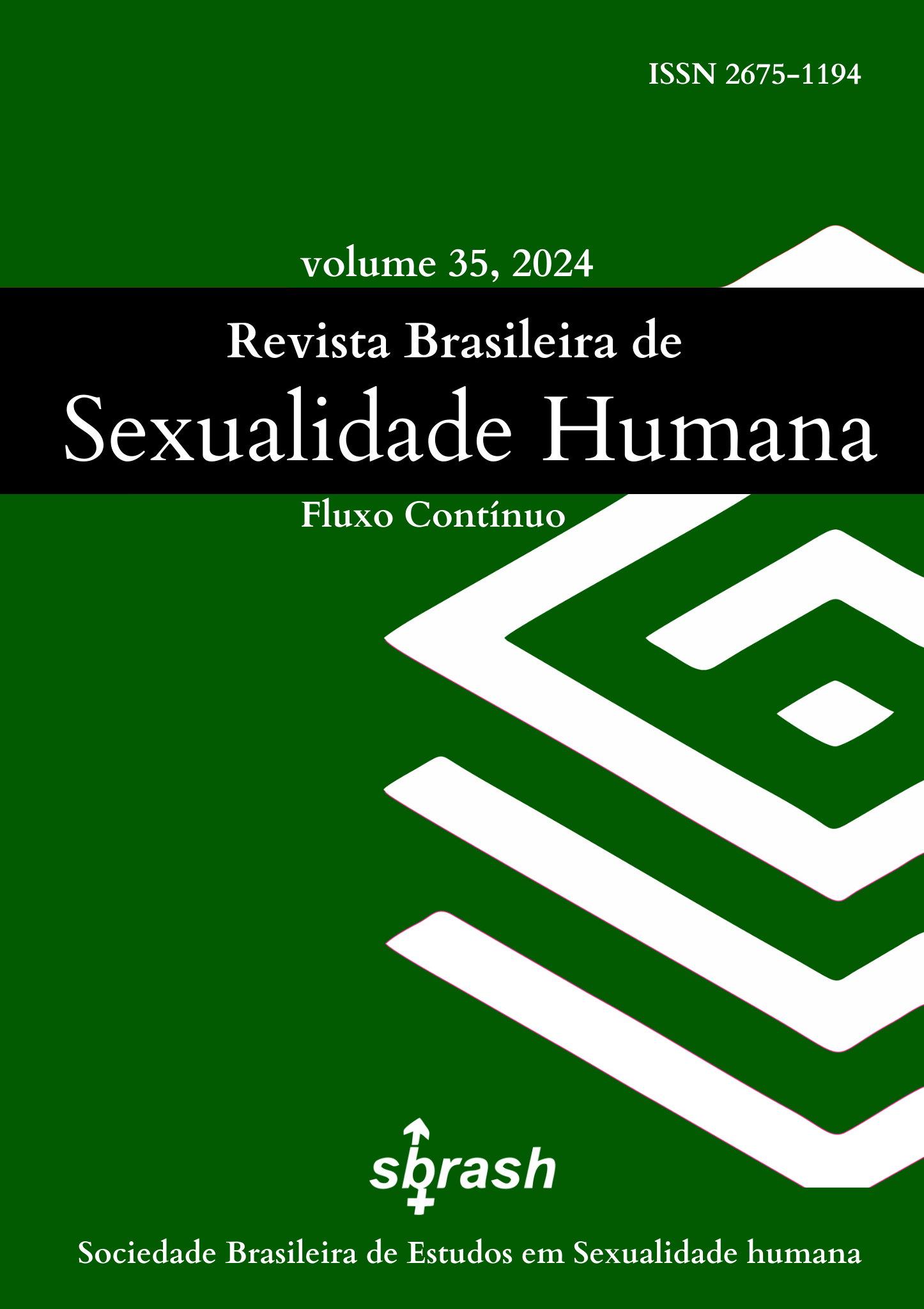IT´S A TRANS WORLD – ANALYZING 10 YEARS OF CLINICAL SEXOLOGY CONSULTATIONS IN A TERTIARY HOSPITAL CENTER IN PORTUGAL.
DOI:
https://doi.org/10.35919/rbsh.v35.1160Keywords:
Sexology, Sociodemographic Factors, Gender incongruence, Erectile DysfunctionAbstract
Objective: The aim was to characterize the evolution of referrals to the Clinical Sexology Consultation at a tertiary hospital center in Portugal. Material and Methods: We analyzed a cohort of patients referred in the period between 2012 and 2021, and data was extracted regarding the number of referrals, absenteeism rate at the first consultation, sociodemographic characterization, diagnosis, and referring entities. Results: A total of 859 referrals were found, with an average absenteeism rate of 23.52%. In recent years, there has been an equalization between the sexes and a greater demand from younger people. We noticed a progressive decrease in married/common-law marriage patients and a progressive increase in single patients seeking this consultation. Regarding the most frequent diagnosis, there was a statistically significant decrease in referrals for HA01.1 erectile dysfunction, from 33.33% in 2012 to 8.87% in 2021. This trend was accompanied by a statistically significant increase in referrals for HA60 gender incongruence, from 25.25% in 2012 to 46.77% in 2021. Conclusions: The typical profile of the patient currently seeking this consultation corresponds to a person that is young, single, and diagnosed with gender incongruence. Changes in demand for this consultation are significant and may reflect changes in today´s society and/or the healthcare system.
Downloads
References
AITKEN, M. et al. Evidence for an altered sex ratio in clinic-referred adolescents with gender dysphoria. The journal of sexual medicine, v. 12, n. 3, p. 756–763, 2015. DOI: https://doi.org/10.1111/jsm.12817
ALARCÃO, V. et al. Clinical Practice in Portuguese Sexology. Journal of Sex & Marital Therapy, v. 43, n. 8, p. 760-773, 2016. DOI: https://doi.org/10.1080/0092623X.2016.1266537
AYTA, I. A. et al. The likely worldwide increase in erectile dysfunction between 1995 and 2025 and some possible policy consequences. BJU international, v. 84, n. 1, p. 50-66, 1999. DOI: https://doi.org/10.1046/j.1464-410x.1999.00142.x
PORTUGAL. Lei n.º 38/2018, de 07 de agosto. Autodeterminação da identidade de género e expressão de género. Disponível em: https://www.pgdlisboa.pt/leis/lei_mostra_articulado.php?nid=2926&tabela=leis&ficha=1&pagina=1&so_miolo=
DHEJNE, C. et al. Mental health and gender dysphoria: A review of the literature. Gender Dysphoria and Gender Incongruence, v. 28, n. 1, p. 44-57, 2016. DOI: https://doi.org/10.3109/09540261.2015.1115753
DONNELLY, L. Rise in child transgender referrals. The Telegraph. 2015. Disponível em: http://www.telegraph.co.uk/news/health/news/11519603/Rise-in-child-transgender-referrals.html. Acesso em: 30 ago. 2023.
KESSLER, A. et al. The global prevalence of erectile dysfunction: a review. BJU international, v. 124, n. 4, p. 587-599, 2019. DOI: https://doi.org/10.1111/bju.14813
MASOUDI, M. et al. Effects of the COVID-19 pandemic on sexual functioning and activity: a systematic review and meta-analysis. BMC Public Health, v. 22, n. 1, p. 189, 2022. DOI: https://doi.org/10.1186/s12889-021-12390-4
MOYNIHAN, et al. Impact of COVID-19 pandemic on utilisation of healthcare services: a systematic review. BMJ Open, v. 11, n. e045343, 2021. DOI: https://doi.org/10.1136/bmjopen-2020-045343
PALACIOS et al. Epidemiology of female sexual dysfunction. Maturitas, v. 63, n. 2, p. 119-123, 2009. DOI: https://doi.org/10.1016/j.maturitas.2009.04.002
POZZI, E. et al. Trends in reported male sexual dysfunction over the past decade: an evolving landscape. International Journal of Impotence Research, v. 33, n. 6, p. 596-602, 2021. DOI: https://doi.org/10.1038/s41443-020-0324-7
SILVA, J. F. et al. Recognizing the diversity of the Portuguese transgender population: A cross-sectional study. Sexologies, v. 31, n. 4, p. 380-386, 2022. DOI: https://doi.org/10.1016/j.sexol.2022.09.002
ZUCKER, K. J. Epidemiology of gender dysphoria and transgender identity. Sex Health, v. 14, n. 5, p. 404-411, 2017. DOI: https://doi.org/10.1071/SH17067
Downloads
Published
How to Cite
Issue
Section
License
Copyright (c) 2024 Tânia Patrícia Vasques Alves, Márcia Gabriel Marques Mota

This work is licensed under a Creative Commons Attribution 4.0 International License.



